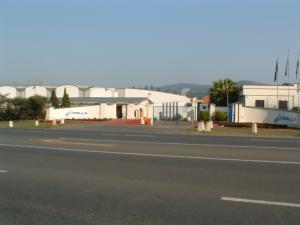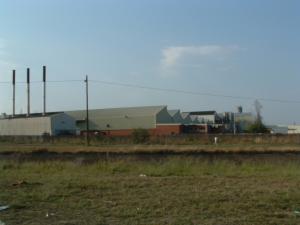 |
Textiles and ClothingIn the South African textiles, clothing and leather sub-
sector, which represents 15% of the manufacturing sector,
textiles contributed 54% at R1.6-billion and clothing 27%
at R0.8-billion.
As well as supplying the domestic market, the textile
manufacturing sector has an export bias and nearly a third
of South Africa's manufactured textile exports originate
in KwaZulu-Natal. The IndustryThe textiles, clothing and footwear industry is well
established in South Africa. The industry consists of
around 300 manufacturers, based mainly in KwaZulu-Natal,
the Western Cape, the Eastern Cape and Gauteng. Statistics
SA data indicate that employment dropped in the clothing,
textile and footwear industries from 206 947 in January
2003 to 142 203 in June 2006 (a loss of 64 744 jobs). The
direct cause of the decline in employment is the surge of
Chinese imports over the past 3 years.
Employment in the textile industry alone has declined from
70 500 in 2003 to just below 50 500 in 2006, according to
the textile federation. Textiles exports grew 60% from
1995 to 2002, but declined 35.6% through 2003 and 2004.
Wearing apparel performed more impressively with 2002
levels 227% higher than in 1995. However, 2003 and 2004
also saw export levels decline significantly, contracting
by 45.9% in real terms.

Textile Factory
|
The import of textiles and clothing to the South African
market by China has put increasing strain on the domestic
manufacturing industry, leading to the demise of a number
of companies, including KwaZulu-Natal’s largest
textile
manufacturer. The company, which closed its doors at the
end of 2004, blamed cheap imports from India, China,
Pakistan and Indonesia for a R200m loss of turnover in the
last two years that it operated.
The textile industry in South Africa can be segmented into
the following major sectors:
• Fibre production
• Spinning
• Weaving
• Knitting
• Non-wovens
• Carpet production
• Fabric Coating

Carpet Factory
|
Textiles and ApparelThe fibre consumption is 247,000 tons per annum by South
Africa’s textile industry’s 460,000 spindles
for spinning yarn and 3,000 looms and 2,000 knitting
machines to convert the yarn into 560 million sq metres of
fabric. The fabric is then converted by the apparel
industry into 191 million apparel units. Apparel covering
most of the ranges in men's, ladies and children's wear are
produced mainly in the Western Cape, KwaZulu-Natal, Gauteng
and Eastern Cape
regions.
Some companies, of which one is based in Ladysmith,
process the fibre or raw cotton into yarn or cotton. This
cotton, of which approximately 3300 tons are produced
annually, is distributed to Pietermaritzburg and Durban to
be used in the textile industry.
The clothing sector is also well established, with three
levels of manufacturers in KwaZulu-Natal. There are
approximately 525 clothing firms, 416 of which are based
in Durban, Pinetown, Inanda and Chatsworth. Of these, at
least 320 are operations handling cut, make and trim.
Other participants are design houses and independent
retailers who specialise in pre-production and
distribution.
A company based in Pietermaritzburg that processes fibre
and yarn to manufacture carpets, imports 10,140 tons of
raw products annually from Europe. The raw materials such
as nylon polymer and latex that are used in the
manufacturing of these carpets originate from Belgium and
Germany respectively. The primary and secondary backing
originates from Saudi Arabia and Belgium. All these raw
products are shipped in 6 and 12 metre containers from
Europe and Saudi Arabia to the port of Durban. The company
produces approximately 9,932 tons of carpets per year,
which are distributed by road to the rest of KwaZulu-Natal,
all over South Africa and exported to Australia,
Saudi Arabia, South America and the Far East. Imports are at an all-time high. Imports of yarns have
increased from 77,000 tons in 2001 to 99,000 tons in 2006
- an increase of 29% - while imports of fabrics have
remained relatively constant with 94,900 tons in 2001 and
95,300 tons in 2006. A significant increase was in the
imports of made-up textiles - from 4,900 tons in 2001 to
28,700 tons in 2006 (nearly 500%), and imports of clothing
from 139 million items in 2001 to 567 million items in 2006
(over 300%).
In the case of clothing imports, 89% currently originates
from China, 3% from India and the remaining 8% from the
rest of the world, while 60% of all made-up textiles
(blankets, bed sheets, towels and curtains) originate from
China.
The textile industry statistics are listed in the table
below.
Footwear IndustryThe domestic footwear industry consists of
approximately 112 manufacturers under the umbrella of the
Southern African Footwear and Leather Industries
Association (SAFLIA) and the National Bargaining Council,
and at least 60 other SMMEs.
Approximately 60-62 % of footwear (by volume)
manufactured in South Africa takes place in KwaZulu-Natal,
and therefore it is the predominant footwear producing
area in South Africa, followed by the Western Cape with an
approximate share of 23%. It is estimated that the large
chain stores control at least 35% of the local retail
market. These situations are changing rapidly as
customers are becoming more and more price and quality
sensitive and are shopping at cash stores. The balance of
footwear production is located in the Eastern Cape (11%)
and Northern Province (4%). TransportDetails of the tons of different commodities that may have
been imported or exported through Durban are unobtainable
due to the fact that all such movements are in containers,
and are therefore not recorded by the port authorities.
In addition, the measurement of the transport task is
complicated by the fact that outputs of the various
factories are measured in a range of units such as square
metres (carpets), pairs (shoes), dozens (many items), and
very few undertakings have records of the weight of their
products.
|
 |



